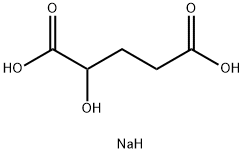α-Hydroxyglutaric acid (2-HG) is an α-hydroxy acid. It is metabolized to 2-oxoglutarate by D- and L-2-hydroxyglutarate dehydrogenases, and mutations in these enzymes lead to 2-hydroxyglutaric aciduria, a neurometabolic disorder characterized by increased levels of L-2-hydroxyglutaric acid . 2-HG can also be metabolized from isocitrate by mutated forms of isocitrate dehydrogenase 1 (IDH1) and IDH2. 2-HG is structurally similar to α-ketoglutarate, the product of wild-type isocitrate dehydrogenases, and competitively inhibits α-ketoglutarate-dependent dioxygenases, including histone lysine demethylases and DNA hydroxylases.
D-(or R-) enantiomer of α-hydroxyglutaric acid is a cancer related biomarker of diagnostic value, whereas the L-(or S-) enantiomer of α-hydroxyglutaric acid is a biomarker for certain neurometabolic, inherited disorder diseases. It has no known physiological function in eukaryotes. It is toxic to the brain and increases the susceptibility to develop brain tumors.
in humans the enzyme hydroxyacid-oxoacid transhydrogenase catalyzed the formation of d-α-hydroxyglutaric acid, while d-α-hydroxyglutaric acid is catalyzed by 2-hydroxyglutarate synthase in bacteria. recent study discovered heterozygous somatic mutations in the genes encoding isocitrate dehydrogenase-1 and -2 (idh1 and idh2) and these mutations could disable the enzymes' ability to convert 2-ketoglutarate to d-α-hydroxyglutarate. the authors also found heterozygous germline mutations in idh2 that alter enzyme residue in patients with d-2-hydroxyglutaric aciduria, a neurometabolic disorder characterized by supraphysiological levels of d-α-hydroxyglutaric acid [1].
previous animal study demonstrated that the overexpression of the isocitrate dehydrogenase-1 (idh1) mutation resulted in detectable levels of d-α-hydroxyglutaric acid in a mouse glioma model that could be measured in vivo and noninvasively by mrs. results showed that this mouse model system was of potential application in establishing the relationships among d-α-hydroxyglutaric acid levels and treatment effect, outcomes, as well as other related and necessary variables to validate d-α-hydroxyglutaric acid as a clinically important biomarker for glioma [2].
[1] kranendijk m,struys ea,van schaftingen e,gibson km,kanhai wa,van der knaap ms,amiel j,buist nr,das am,de klerk jb,feigenbaum as,grange dk,hofstede fc,holme e,kirk ep,korman sh,morava e,morris a,smeitink j,sukhai rn,vallance h,jakobs c,salomons gs. idh2 mutations in patients with d-2-hydroxyglutaric aciduria. science.2010 oct 15;330(6002):336.
[2] lazovic j,soto h,piccioni d,lou jr,li s,mirsadraei l,yong w,prins r,liau lm,ellingson bm,cloughesy tf,lai a,pope wb. detection of 2-hydroxyglutaric acid in vivo by proton magnetic resonance spectroscopy in u87 glioma cells overexpressing isocitrate dehydrogenase-1 mutation. neuro oncol.2012 dec;14(12):1465-72.

